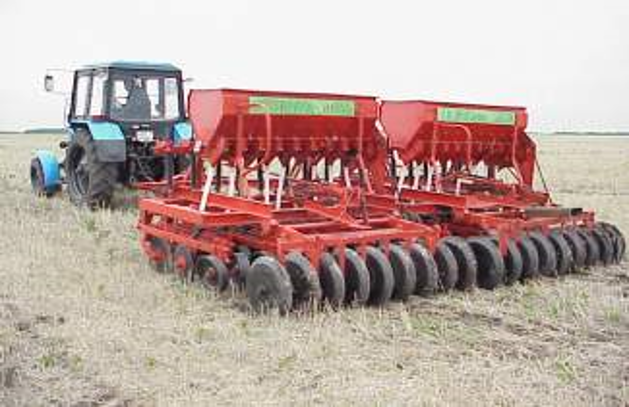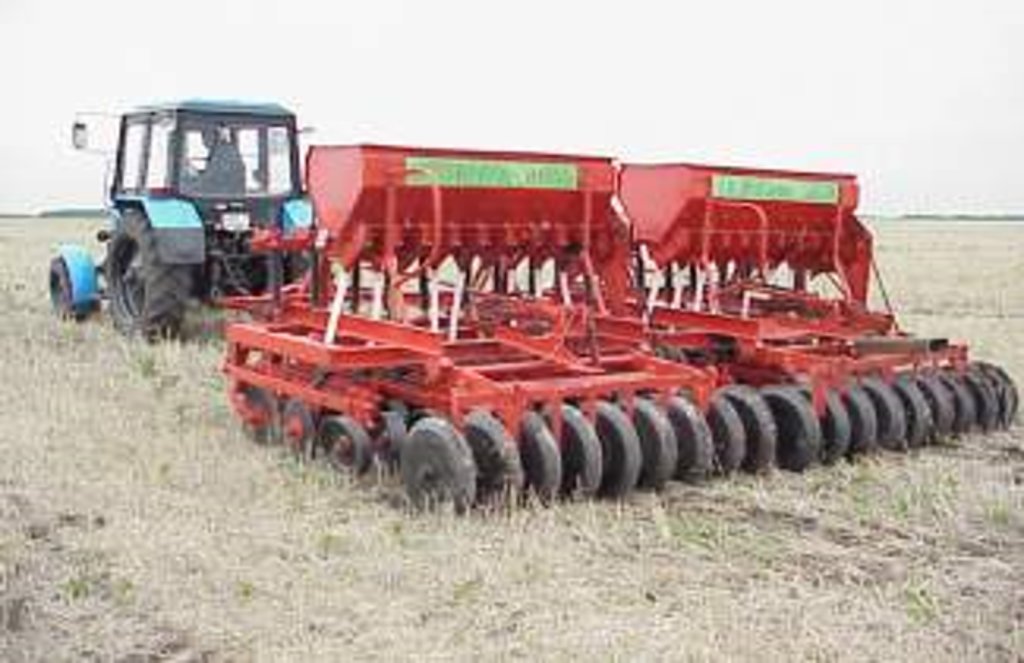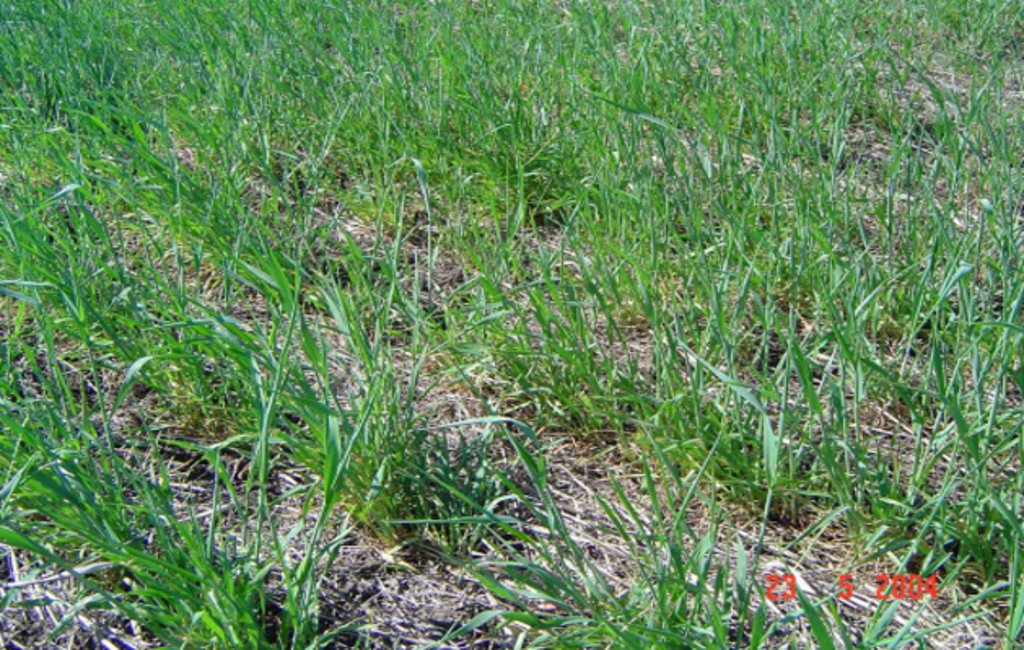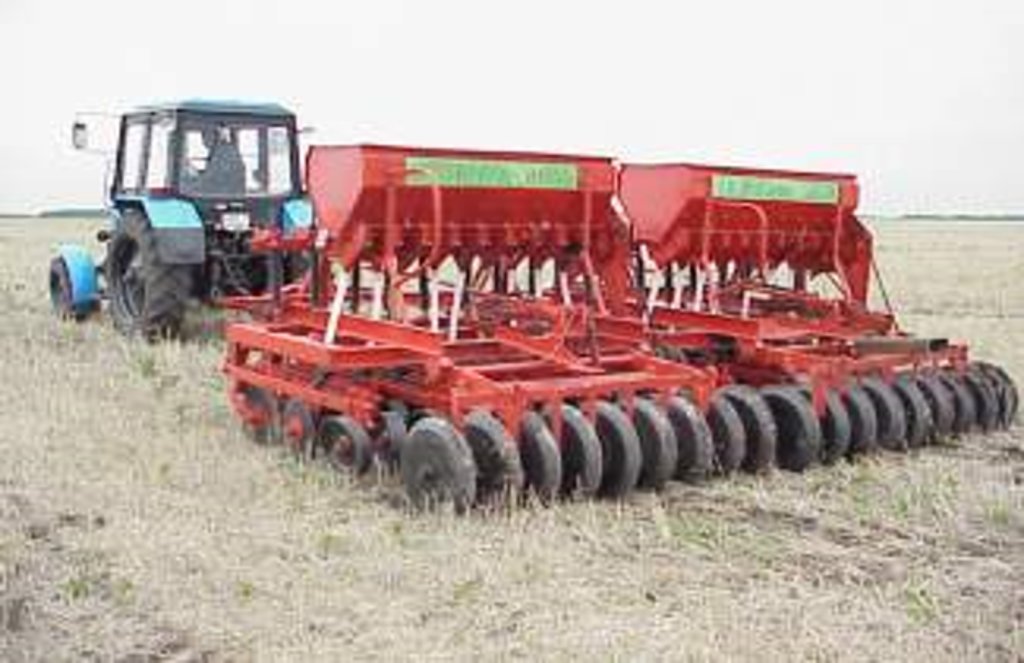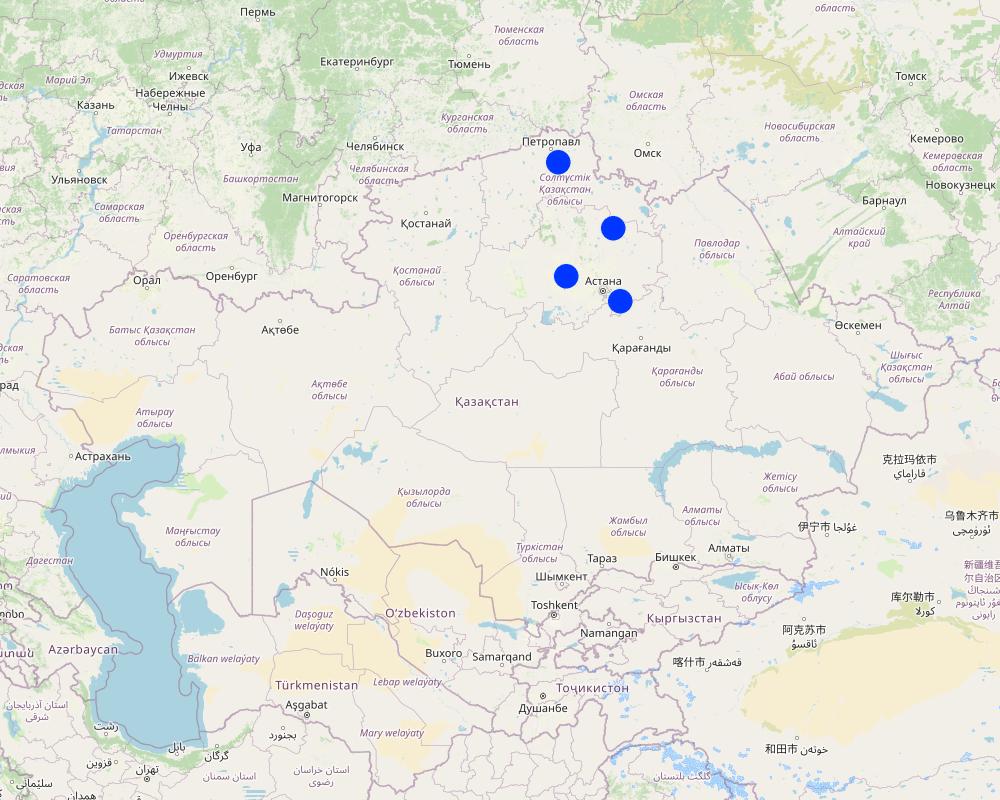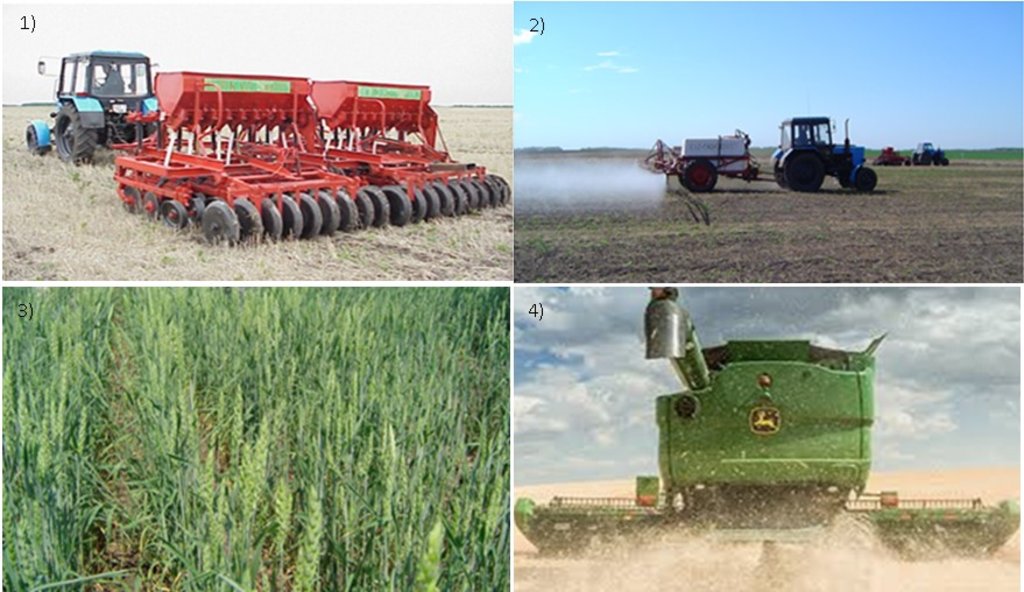Conservation Agriculture for cereal production in rainfed areas of Kazakhstan [哈萨克斯坦]
- 创建:
- 更新:
- 编制者: Kulyash Iskandarova
- 编辑者: Hayot Ibrakhimov
- 审查者: Rima Mekdaschi Studer
Conservation Agriculture for cereals production in rainfed agriculture lands
technologies_5673 - 哈萨克斯坦
查看章节
全部展开 全部收起1. 一般信息
1.2 参与该技术评估和文件编制的资源人员和机构的联系方式
关键资源人
Expert/Consultant:
Karabayev Muratbek
CIMMYT-Kazakhstan
哈萨克斯坦
有助于对技术进行记录/评估的项目名称(如相关)
Integrated natural resources management in drought-prone and salt-affected agricultural production landscapes in Central Asia and Turkey ((CACILM-2))有助于对技术进行记录/评估的机构名称(如相关)
Kazakh Research Institute for Livestock and Fodder Production (Kazakh Research Institute for Livestock and Fodder Production) - 哈萨克斯坦1.3 关于使用通过WOCAT记录的数据的条件
编制者和关键资源人员接受有关使用通过WOCAT记录数据的条件。:
是
1.4 所述技术的可持续性声明
这里所描述的技术在土地退化方面是否存在问题,导致无法被认为是一种可持续的土地管理技术?:
否
注释:
The technology helps to restore degraded land
1.5 参考关于SLM方法(使用WOCAT记录的SLM方法)的调查问卷
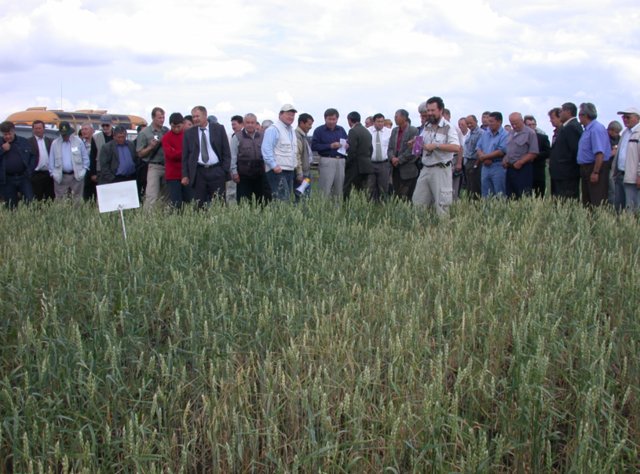
Awareness Raising for SLM Using Conservation Agriculture [哈萨克斯坦]
Raising awareness and strengthening the capability and skills of farmers, agriculture specialists and researchers in developing and adoption resource-saving, profitable and environmentally friendly cereal production through Conservation Agriculture practices.
- 编制者: Kulyash Iskandarova
2. SLM技术的说明
2.1 技术简介
技术定义:
Conservation agriculture applied in Northern Kazakhstan is based on no-tillage direct sowing of cereals into the soil permanently covered by crop residues. It contributes to reverse soil degradation, enhance water use efficiency, increase crop productivity in the rainfed lands.
2.2 技术的详细说明
说明:
The cropping system in Northern Kazakhstan is based mainly on continuous wheat production using conventional technologies. Negative components of this system are intensive tillage, returning little organic matter to the land and monoculture. This system has led to soil degradation (wind and water erosion), soil fertility loss, boost-up of diseases, weed infestation and other problems.
Conservation Agriculture (CA) involves removing these negative components of conventional farming systems and includes three basic principles: 1) minimal soil disturbance, 2) permanent soil cover with crop residues and 3) crop rotation.
In accordance with these principles,
Conservation Agriculture technology includes 3 main operations:
1. Sowing with simultaneously soil fertilization using direct seeder.
2. Post-sowing (after 1-2 days) treatment by non-selective herbicide
3. Harvesting combined with simultaneous plant residues chopping and spreading
For comparison Conventional technology includes 7 operations:
1. Deep fall soil tillage (25 cm).
2. Early spring soil treatment.
4. Pre-sowing soil treatment.
5. Sowing with simultaneously soil fertilization using conventional seeder.
6. Selective herbicide application 2,4-Dichlorophenoxyacetic acid (2-4-D).
7. Harvesting.
The CA technology was applied in four farms in Akmola and North-Kazakhstan oblasts:
1.Farm “DARYN”, village Valikhanovo, Zharkainsky rayon, Akmola oblast, Kazakhstan.
2.Farm “Surayev”, village Vishnevka, Arshalinsky rayon, Akmola oblast, Kazakhstan.
3.Farm “Dostyk”, village Astrahanovka, Arshalinsky rayon, Akmola oblast, Kazakhstan.
4. Farm “Cherezdanov”, village Smirnovo, Akkayinskii rayon, Northern Kazakhstan oblast, Kazakhstan.
Depending on the capability of these four farms in total 330 ha agricultural land were allocated for the testing and adaptation of the technology. On each farm, field trials under equal conditions (soil, temperature, humidity, landscape, etc.) were conducted and included 2 treatments: Conventional (7 operations) and Conservation Agriculture (3 operations).
Analysis of 2002-2004 trials data demonstrated that yield of wheat and other cereals under CA technology was in average 15-25% higher in comparison with the conventional technology. The advantages of CA technology are especially evident in the years of drought (up to 40% in dry 2004 year). Economic evaluation of the technology made by two independent experts from Kazakhstan (Kazakh Research Institute for Grain Farming) and USA (Idaho State University) suggested that costs of labor, fuel, repairs and spare parts as well as machinery and equipment wearing-out under the Conservation Agriculture technologies is significantly lower as compared to those of traditional technology. In general, it is important to emphasize that the experience of the CA adaptation in North Kazakhstan helped farmers/land-users:
•To determine the appropriate level of tillage in a cropping system that is feasible with direct sowing and CA technology requirements as a potential goal.
•To retain sufficient residue on the soil surface to reduce soil erosion, enhance crop/water productivity, improve soil fertility (because of plant organic material bioprocessing in the soil) and better ensure long term, sustainable production.
•Employ economically viable, diversified crop rotations that can improve cropping system productivity and offer farmers new options to reduce risk that is extremely important for the conditions of Northern Kazakhstan relating to the area of risk farming.
The introduction of the technology for cereal production in the rainfed areas of Kazakhstan was realized within the framework of the FAO/TCP/KAZ/2801 (T) Project “Conservation Agriculture for Sustainable Crop Production in Northern Kazakhstan”, under active cooperation with counterparts: Ministry of Agriculture of the Republic of Kazakhstan (MoA RK), FAO, CIMMYT, Union of Farmers of Kazakhstan (UFK), national agriculture research organizations.
2.3 技术照片
2.4 技术视频
注释、简短说明:
not available
2.5 已应用该技术的、本评估所涵盖的国家/地区/地点
国家:
哈萨克斯坦
区域/州/省:
Northern Kazakhstan: Akmola and North Kazakhstan regions (provinces)
有关地点的进一步说明:
Smirnovo village, Akkayin district, Northern Kazakhstan region; Valikhanovo village, Zharkainsk district, Akmola region; Astrahanovka village, Astrahanskyi district, Akmola region; 4) Vishnevka village, Arshalinsky district, Akmola region
具体说明该技术的分布:
- 均匀地分布在一个区域
技术现场是否位于永久保护区?:
否
注释:
1) Farm “Cherezdanov”, Smirnovo village, Akkayin district, Northern Kazakhstan region, located approximately 60 kilometers south of Petropavlovsk and 700 km from Astana (Nur-Sultan). The farm Head is Vyacheslav Cherezdanov.
2) Farm “Daryn”, Valikhanovo village, Zharkainsk district, Akmola region, located approximately 600 kilometers southwest of Astana (Nur-Sultan). The Head is Auezkhan Darynov.
3) Farm “Dostyk 06”, Astrahanovka village, Astrahanskyi district, Akmola region, located approximately 110 kilometers west of Astana (Nur-Sultan). The Head is Meyram Sagimbayev.
4) Farm “Surayev”, Vishnevka village, Arshalinsky district, Akmola region, located approximately 60 kilometers south of Astana (Nur-Sultan). The Head is Viktor Surayev.
Map
×2.6 实施日期
注明实施年份:
2002
2.7 技术介绍
详细说明该技术是如何引入的:
- 通过项目/外部干预
注释(项目类型等):
FAO TCP/KAZ/2801 (T) Project “Conservation Agriculture for Sustainable Crop Production in Northern Kazakhstan”
The project was initiated by UN Food and Agricultural Organization (FAO) under active cooperation with counterparts: Ministry of Agriculture of the Republic of Kazakhstan (MoA RK), FAO, CIMMYT, Union of Farmers of Kazakhstan (UFK), national agriculture research organizations. The project was aimed to testing, adaptation and introduction of Conservation Agriculture technology for cereal production in Northern Kazakhstan. At the present time the technology is applied on the area of around 3 mln ha in Northern Kazakhstan.
3. SLM技术的分类
3.1 该技术的主要目的
- 改良生产
- 减少、预防、恢复土地退化
- 保持/提高生物多样性
- 适应气候变化/极端天气及其影响
- 创造有益的经济影响
3.2 应用该技术的当前土地利用类型
同一土地单元内混合使用的土地::
否

农田
- 一年一作
年作 - 具体指明作物:
- 谷类 - 燕麦
- 谷类 - 小麦(春季)
- 谷类 - 黑麦
- 谷类 - 大麦
每年的生长季节数:
- 1
采用间作制度了吗?:
否
采用轮作制度了吗?:
是
如果是,请具体说明:
Crop rotations at the project farms.
(In average, spring wheat occupies 50% of lands in crop rotations)
Plot/ field1st year2nd year3rd year
#1 Wheat Barley Wheat
#2 Rye Wheat Oat
#3 Wheat Oat Wheat
#4 Barley Wheat Rye
3.3 由于技术的实施,土地使用是否发生了变化?
由于技术的实施,土地使用是否发生了变化?:
- 否(继续问题3.4)
同一土地单元内混合使用的土地::
否
3.4 供水
该技术所应用土地的供水:
- 雨养
注释:
average annual rainfall: 250 mm
3.5 该技术所属的SLM组
- 改良的地面/植被覆盖
- 最小的土壤扰动
3.6 包含该技术的可持续土地管理措施

农艺措施
- A2:有机质/土壤肥力
- A3:土壤表面处理
- A6:残株管理
A3:区分耕作制度:
A 3.1:免耕
A6:对残株管理作出具体说明:
A 6.4:保留
注释:
CA technology implies retention plant residues (chopped and spread) in the field. This is organic matter in huge quantities. Due to biological processing of this substance the soil fertility as well as soil quality are improved.
3.7 该技术强调的主要土地退化类型

土壤水蚀
- Wt:表土流失/地表侵蚀

土壤风蚀
- Et:表土流失

物理性土壤退化
- Pc:压实

其它
具体说明:
loss of soil fertility due to wind and water erosion
3.8 防止、减少或恢复土地退化
具体数量名该技术与土地退化有关的目标:
- 减少土地退化
4. 技术规范、实施活动、投入和成本
4.1 该技术的技术图纸
技术规范(与技术图纸相关):
Sequence of main operations and elements of the technology implemented:
1) Direct sowing of wheat with seeder SZS 6.12 equipped with brazil disk openers and cutting discs, and simultaneous ammophos application at the rate of Р20
2) Herbicide treatment (Glyphosate 360) with sprayer OP-2000, 3.0 l/ha after wheat planting
3) Direct sowing spring wheat
4) Harvesting with chopping and overspreading of the straw
Technical specifications, dimensions, spacing of the experimental plots:
The total land area under the technology - 330 ha for 4 farms: «Cherezdanov», «Dostyk 06», «Suraev», «Daryn» (20 plots , 16.5 ha each)
1 plot - 16.5 ha (length - 702 m, width - 235 m)
Species used: wheat, barely, rye, oat. Different seed rates of spring wheat are used at the farms: from 105 kg/ha to 140 kg/ha.
作者:
Muratbek Karabayev
日期:
09/08/2004
4.2 有关投入和成本计算的一般信息
具体说明成本和投入是如何计算的:
- 每个技术区域
注明尺寸和面积单位:
330 ha
具体说明成本计算所用货币:
- 美元
注明雇用劳工的每日平均工资成本:
22 USD
4.3 技术建立活动
| 活动 | 时间(季度) | |
|---|---|---|
| 1. | Snow Retention | Dec-Feb |
| 2. | Herbicides (Glyphosate) Application | May |
| 3. | Direct sowing, fertilizing | May |
| 4. | Herbicide Application | June |
| 5. | Harvest and Hauling | Aug-Sep |
注释:
SNOW RETENTION: By leaving stubbles on the field to improve soil moisture storage.
HAULING: Farmers in Kazakhstan have to transport harvested yield to the special Grain storage/elevator, located distantly remotely, usually it is one elevator for one district. This is transportation expenses
4.4 技术建立所需要的费用和投入
| 对投入进行具体说明 | 单位 | 数量 | 单位成本 | 每项投入的总成本 | 土地使用者承担的成本% | |
|---|---|---|---|---|---|---|
| 劳动力 | Permanent and seasonal workers | person-days | 242.7 | 22.0 | 5339.4 | |
| 设备 | Fuel | liter | 5374.28 | 0.35 | 1881.0 | |
| 设备 | Modification of seeders and sprayers | 2.0 | 1240.8 | 2481.6 | ||
| 设备 | Machinery Depreciation (7 Unit of equipment) | 7.0 | 1427.5 | 9992.5 | 100.0 | |
| 设备 | Machinery Interest (7 Unit of equipment) | 7.0 | 646.4 | 4524.8 | 100.0 | |
| 植物材料 | Wheat Seed | kg | 40764.7 | 0.17 | 6930.0 | |
| 肥料和杀菌剂 | Fertilizer: Ammonium Phosphate | kg | 33000.0 | 0.1 | 3300.0 | |
| 肥料和杀菌剂 | Herbicide: Broadleaf | liter | 330.0 | 5.5 | 1815.0 | |
| 肥料和杀菌剂 | Herbicide: Glyphosate | liter | 990.0 | 6.5 | 6435.0 | |
| 其它 | Land | ha | 330.0 | 12.88 | 4250.4 | 100.0 |
| 技术建立所需总成本 | 46949.7 | |||||
| 技术建立总成本,美元 | 46949.7 | |||||
如果土地使用者负担的费用少于100%,请注明由谁负担其余费用:
The contribution from land users (4 Farms) were amounted to 18 767,7 USD. The remaining costs were covered by the funds of the project FAO / TCP / KAZ / 2801 (T) Project “Conservation Agriculture for Sustainable Crop Production in Northern Kazakhstan”
注释:
- The "Labor" section provides the average data on the salary costs of permanent and seasonal workers
- Total costs for establishment of the Technology per 1 ha is 142,27 USD
- In general, the stage of establishment requires more expenses, in particular for acquiring a direct seeder or modifying the traditional one. In this case the additional expenses were made for modification of local seeders and sprayers.
4.5 维护/经常性活动
| 活动 | 时间/频率 | |
|---|---|---|
| 1. | Snow Retention | Dec-Feb |
| 2. | Herbicides (Glyphosate) Application | May |
| 3. | Direct sowing, fertilizing | May |
| 4. | Herbicide Application | June |
| 5. | Harvest and Hauling | Aug-Sep |
4.6 维护/经常性活动所需要的费用和投入(每年)
| 对投入进行具体说明 | 单位 | 数量 | 单位成本 | 每项投入的总成本 | 土地使用者承担的成本% | |
|---|---|---|---|---|---|---|
| 劳动力 | Permanent and Seasonal Workers | person/days | 242.7 | 22.0 | 5339.4 | |
| 设备 | Fuel | liter | 5374.28 | 0.35 | 1881.0 | |
| 设备 | Equipment repairs and service | 2.0 | 1240.8 | 2481.6 | ||
| 设备 | Machinery Depreciation (7 Unit of equipment) | 7.0 | 1427.5 | 9992.5 | 100.0 | |
| 设备 | Machinery Interest (7 Unit of equipment) | 7.0 | 646.4 | 4524.8 | 100.0 | |
| 植物材料 | Wheat seads | kg | 40764.7 | 0.17 | 6930.0 | |
| 肥料和杀菌剂 | Fertilizer: Ammonium Phosphate | kg | 33000.0 | 0.1 | 3300.0 | |
| 肥料和杀菌剂 | Herbicide: Broadleaf | liter | 330.0 | 5.5 | 1815.0 | |
| 肥料和杀菌剂 | Herbicide: Glyphosate | liter | 825.0 | 6.5 | 5362.5 | |
| 其它 | Land | ha | 330.0 | 12.88 | 4250.4 | 100.0 |
| 技术维护所需总成本 | 45877.2 | |||||
| 技术维护总成本,美元 | 45877.2 | |||||
如果土地使用者负担的费用少于100%,请注明由谁负担其余费用:
The contribution from land users (4 Farms) amounted to 18767.7 USD. The remaining costs were covered by the funds of the project FAO / TCP / KAZ / 2801 (T) Project “Conservation Agriculture for Sustainable Crop Production in Northern Kazakhstan”
注释:
The "Labor" section provides the average data on the salary costs of permanent and seasonal workers.
Total costs for maintenance of the Technology per 1 ha is 139,0 USD
The totals of establishment and maintenance costs not the same due to the difference in the rate of use of the glyphosate herbicide (3 l/ha vs 2.5 l / ha)
4.7 影响成本的最重要因素
描述影响成本的最决定性因素:
CA technology shows some clear economic advantages compared to the traditional system. Production costs for CA are slightly higher, associated primarily with the cost of glyphosate. But they are partially reimbursed by lower costs fot labor, fuel and ownership costs associated with a slight reduction in equipment use. However, additional revenue associated with the higher yields experienced for CA compensates for the higher production costs.
5. 自然和人文环境
5.1 气候
年降雨量
- < 250毫米
- 251-500毫米
- 501-750毫米
- 751-1,000毫米
- 1,001-1,500毫米
- 1,501-2,000毫米
- 2,001-3,000毫米
- 3,001-4,000毫米
- > 4,000毫米
指定年平均降雨量(若已知),单位为mm:
250.00
有关降雨的规范/注释:
Short growing period, low rainfall during the growing period, frequent droughts, early and late frosts
注明所考虑的参考气象站名称:
“KazHydroMet” National State Organization
农业气候带
- 半干旱
Farm “Cherezdanov”, Smirnovo village, Akkayinskii rayon, Northern Kazakhstan oblast: mean annual rainfall, mm - 333,4; mean annual temperature (degrees Celsius) - +1,6;
Farm “Dostyk 06”, Astrahanovka village, Astrahanskyi rayon, Akmola oblast: mean annual rainfall, mm - 319,6; mean annual temperature (degrees Celsius) - +1,6;
Farm “Surayev”, Arshalinsky rayon, Akmola oblast: mean annual rainfall, mm - 312,8; mean annual temperature (degrees Celsius) - +2,4;
Farm “Daryn”, Valikhanovo village, Zharkainsky rayon, Akmola oblast: mean annual rainfall, mm - 253,4; mean annual temperature (degrees Celsius) - +2,5
5.2 地形
平均坡度:
- 水平(0-2%)
- 缓降(3-5%)
- 平缓(6-10%)
- 滚坡(11-15%)
- 崎岖(16-30%)
- 陡峭(31-60%)
- 非常陡峭(>60%)
地形:
- 高原/平原
- 山脊
- 山坡
- 山地斜坡
- 麓坡
- 谷底
垂直分布带:
- 0-100 m a.s.l.
- 101-500 m a.s.l.
- 501-1,000 m a.s.l.
- 1,001-1,500 m a.s.l.
- 1,501-2,000 m a.s.l.
- 2,001-2,500 m a.s.l.
- 2,501-3,000 m a.s.l.
- 3,001-4,000 m a.s.l.
- > 4,000 m a.s.l.
说明该技术是否专门应用于:
- 不相关
5.3 土壤
平均土层深度:
- 非常浅(0-20厘米)
- 浅(21-50厘米)
- 中等深度(51-80厘米)
- 深(81-120厘米)
- 非常深(> 120厘米)
土壤质地(表土):
- 中粒(壤土、粉土)
土壤质地(地表以下> 20厘米):
- 中粒(壤土、粉土)
表土有机质:
- 中(1-3%)
如有可能,附上完整的土壤描述或具体说明可用的信息,例如土壤类型、土壤酸碱度、阳离子交换能力、氮、盐度等。:
Soil depth on average: 1 m.
5.4 水资源可用性和质量
地下水位表:
5-50米
地表水的可用性:
中等
水质(未处理):
不良饮用水(需要处理)
水质请参考::
地下水和地表水
水的盐度有问题吗?:
否
该区域正在发生洪水吗?:
否
5.5 生物多样性
物种多样性:
- 中等
栖息地多样性:
- 中等
5.6 应用该技术的土地使用者的特征
定栖或游牧:
- 定栖的
生产系统的市场定位:
- 混合(生计/商业)
- 商业/市场
非农收入:
- 低于全部收入的10%
- 收入的10-50%
相对财富水平:
- 平均水平
个人或集体:
- 员工(公司、政府)
机械化水平:
- 机械化/电动
性别:
- 女人
- 男人
土地使用者的年龄:
- 中年人
5.7 应用该技术的土地使用者使用的平均土地面积
- < 0.5 公顷
- 0.5-1 公顷
- 1-2 公顷
- 2-5公顷
- 5-15公顷
- 15-50公顷
- 50-100公顷
- 100-500公顷
- 500-1,000公顷
- 1,000-10,000公顷
- > 10,000公顷
这被认为是小规模、中规模还是大规模的(参照当地实际情况)?:
- 中等规模的
5.8 土地所有权、土地使用权和水使用权
土地所有权:
- 州
土地使用权:
- 租赁
用水权:
- 社区(有组织)
土地使用权是否基于传统的法律制度?:
是
具体说明:
Land lease for 49 years
according to the Land code of the Republic of Kazakhstan
注释:
Land ownership in Kazakhstan is on state and individual basis. Lands of large farms are owned by state, and farmers can use these lands only for farming purpose based on long-term agreement (rent) for up to 49 years with relevant state authorities and bodies. Smallholder farmers mostly owned agriculture lands (average size around 10 ha) individually.
5.9 进入服务和基础设施的通道
健康:
- 贫瘠
- 适度的
- 好
教育:
- 贫瘠
- 适度的
- 好
技术援助:
- 贫瘠
- 适度的
- 好
就业(例如非农):
- 贫瘠
- 适度的
- 好
市场:
- 贫瘠
- 适度的
- 好
能源:
- 贫瘠
- 适度的
- 好
道路和交通:
- 贫瘠
- 适度的
- 好
饮用水和卫生设施:
- 贫瘠
- 适度的
- 好
金融服务:
- 贫瘠
- 适度的
- 好
6. 影响和结论性说明
6.1 该技术的现场影响
社会经济效应
生产
作物生产
生产故障风险
土地管理
收入和成本
农业投入费用
农业收入
工作量
社会文化影响
食品安全/自给自足
SLM/土地退化知识
生态影响
水循环/径流
水的回收/收集
地表径流
蒸发
土壤
土壤水分
土壤流失
土壤结壳/密封
土壤压实
养分循环/补给
土壤有机物/地下C
生物多样性:植被、动物
有益物种
减少气候和灾害风险
干旱影响
碳和温室气体的排放
6.2 该技术的场外影响已经显现
温室气体的影响
6.3 技术对渐变气候以及与气候相关的极端情况/灾害的暴露和敏感性(土地使用者认为的极端情况/灾害)
渐变气候
渐变气候
| 季节 | 增加或减少 | 该技术是如何应对的? | |
|---|---|---|---|
| 年温度 | 增加 | 好 | |
| 季节性温度 | 夏季 | 增加 | 好 |
| 年降雨量 | 减少 | 好 | |
| 季雨量 | 夏季 | 减少 | 好 |
气候有关的极端情况(灾害)
气象灾害
| 该技术是如何应对的? | |
|---|---|
| 局地暴雨 | 好 |
| 局地雪暴 | 好 |
| 当地沙尘暴/尘暴 | 好 |
气候灾害
| 该技术是如何应对的? | |
|---|---|
| 干旱 | 好 |
水文灾害
| 该技术是如何应对的? | |
|---|---|
| 山洪暴发 | 好 |
6.4 成本效益分析
技术收益与技术建立成本相比如何(从土地使用者的角度看)?
短期回报:
中性/平衡
长期回报:
积极
技术收益与技术维护成本/经常性成本相比如何(从土地使用者的角度看)?
短期回报:
稍微积极
长期回报:
非常积极
6.5 技术采用
- 11-50%
如若可行,进行量化(住户数量和/或覆盖面积):
about 3 mln ha under Conservation Agriculture in Kazakhstan now
在所有采用这项技术的人当中,有多少人是自发的,即未获得任何物质奖励/付款?:
- 0-10%
注释:
Kazakhstan is now included among the top ten countries with the largest areas under CA in the world (Source: FAOSTAT).
6.6 适应
最近是否对该技术进行了修改以适应不断变化的条件?:
否
6.7 该技术的优点/长处/机会
| 土地使用者眼中的长处/优势/机会 |
|---|
| A special advantage of Conservation Agriculture is observed in extremely dry conditions. It allows to consider this technology as water-conserving, which is critical for risky farming area in Kazakhstan. |
| Conservation Agriculture is not inferior to traditional technologies and is competitive in the regional cereal production system and promising given their role in soil fertility recovery, cost reduction, increase in labor productivity and positive effect on the environment. |
| The wide-scale use of Conservation Agriculture in Kazakhstan, shift of farms to modern cropping systems are realistic and promising. |
| 编制者或其他关键资源人员认为的长处/优势/机会 |
|---|
| Based on the data on yield, ecological, soil and agronomic parameters and economic analysis, the Conservation Agriculture can be considered as effective and promising for the region. It will allow for farmers to switch to modern farming systems based on diversified crop production, minimal soil treatment, stubble retention, and direct seeding. |
| The modified local seeders, in general, performed well and can be used under production conditions. The possibility to locally produce direct seeders and well-established herbicide and fertilizer production suggest feasible wide-scale application of CA technology for crop production in the country. |
| Under current conditions, it is extremely important to intensify collaboration between national agricultural systems and international organizations and research centers. They actively use their large international expertise, modern technologies, rich genetic pool to facilitate a rapid integration of a country’s agrarian sector into the world system. |
6.8 技术的弱点/缺点/风险及其克服方法
| 土地使用者认为的弱点/缺点/风险 | 如何克服它们? |
|---|---|
| High costs at the 1st stage of technology implementation | State support programs or land user cooperation needed |
| Weed control problems | Weed control is one aspect that needs further research. Herbicides are costly in Kazakhstan, especially when compared to depressed grain prices. Options for weed control with different weed spectra and these different conditions must be available. One of the ways to combat is the crop rotation. Potential for more diversified systems in northern Kazakhstan exists. Policy emphasis should be placed on market development for alternative crops. |
| 编制者或其他关键资源人员认为的弱点/缺点/风险 | 如何克服它们? |
|---|---|
| Equipment availability for resource-poor farmers | There are many inexpensive models of direct seeders and other equipment for CA in the world market. Farmers need in marketing services, technical consultations. Subsidizing purchase of CA equipment by government can help farmers to advance the process of CA adoption in country and region. |
| Delayed effect (it takes time to get all the benefits of the technology) | Provision of long-term low interest loans |
| The problem of farmers' awareness of technology, its features and benefits | Awareness needs to be raised |
7. 参考和链接
7.1 信息的方法/来源
- 实地考察、实地调查
4 visits, field days
- 与土地使用者的访谈
4 interviews with land users
- 与SLM专业人员/专家的访谈
2 experts
- 根据报告和其他现有文档进行编译
(现场)数据是什么时候汇编的?:
2012
7.2 参考可用出版物
标题、作者、年份、ISBN:
1.Karabaev M., Vasko I., Matyushkov M., Bektemirov A., Kenzhebekov A., Bakhman T., Friedrich T., Makus L., Morgunov A., Darinov A., Sagimbaev M., Suraev V., Perezdanov V ., Rodionov A., Wall P. Zero-processing and direct sowing technologies for the cultivation of grain crops in Northern Kazakhstan. 2005. FAO-SIMMIT, 64 p. (in Russian)
标题、作者、年份、ISBN:
2.Shpigun S., Karabayev M.No-till and direct seeding technologies for cereals in North Kazakhstan. - Practical recommendations for farmers. Astana, Kazakhstan, 2007, 15 p.
标题、作者、年份、ISBN:
3.Karabayev M., Yuschenko N., Akramkhanov A., and Shpigun S.Forage crops production in dry areas with an allowance for ecological risks. - Methods of seeding and growing of perennial and annual grasses. Astana, Kazakhstan, 2007, 112 p.
标题、作者、年份、ISBN:
4.CIMMYT Wheat Improvement Program for Kazakhstan. Together in 21st Century. - 2008, CIMMYT, 56 p.
标题、作者、年份、ISBN:
5.Yushenko N., Iskakov Z., Karabayev M., Shpigun S., Yushenko D., Shaushekov T., Baitassov A. Perennial grasses cropping in abandoned lands of Central Kazakhstan based on Conservation Agriculture. – Drylands Management, World Bank-GEF-MOEP Kazakhstan, 2008, p.38-43.
标题、作者、年份、ISBN:
6.No-Till with Soil Cover and Crop Rotation: A Basis for Policy Support to Conservation Agriculture for Sustainable Production Intensification. – Proceedings of the International Consultation Conference, 8-10 July, 2009, Astana-Shortandy, Kazakhstan. CIMMYT, FAO, Ministry of Agriculture, Kazakhstan, 2009, p. 350.
标题、作者、年份、ISBN:
7.Commonwealth Agricultural Bureaux International (CABI). 2011. Climate Change and Crop Production. Oxfordshire, UK: CABI, 292 p.
标题、作者、年份、ISBN:
8.FAO (Food and Agriculture Organization of the United Nations). 2011. Save and Grow: A Policymaker’s Guide to the Sustainable Intensification of Smallholder Crop Production. Rome, Italy: FAO.
标题、作者、年份、ISBN:
9.Ospanbayev Zh., Koishibayev M., Karabayev M., Zhapayev R., Bedoshvili D., Zhunusov K. 2010. Winter wheat direct seeding technology on rainfed lands. Recommendations for farmers, Almaty, Kazakhstan, 13 p.
标题、作者、年份、ISBN:
10.Karabayev M., Ushenko N., Baitassov A., Ushenko D., Ishmukhanbetov S. 2011. Conservation agriculture for hayfields and pastures under agricultural landscapes of Central Kazakhstan // INAT-AGRO, GEF, UNDP, CIMMYT. Astana, Kazakhstan, 39 p.
标题、作者、年份、ISBN:
11.Ushenko N., Ushenko D., Baitassov A. 2011. Adaptation of no till and direct seeding of cereals in agricultural landscapes of Central Kazakhstan // CIMMYT, ACP, Astana, Kazakhstan, 22 p.
标题、作者、年份、ISBN:
12.Advancement and impact of conservation agriculture/no-till technology adoption in Kazakhstan. FAO Investment Centre, Information Note, December 6, 2012
标题、作者、年份、ISBN:
13.Karabayev M., P.Wall., K.Sayre, R.Zhapayev, A.Morgounov, V.Dvurechenski, N.Yushenko, T.Friedrich, T.Fillecia, A.Jumabayeva, M.Guadagni. Adoption of Conservation Agriculture in Kazakhstan // Soil-Water Journal. 2013, Vol. 2, # 2, p. 2003-2006.
标题、作者、年份、ISBN:
14.Zhapayev R., K.Iskandarova, M.Karabayev, K.Toderich. Ecological testing of the sorghum genotypes in South-East Kazakhstan // Agroecological bases of improvement the productivity and sustainability of Agriculture in the XXI century. 2013, Kazakhstan, p. 124-127.
标题、作者、年份、ISBN:
15.Karabayev M., V.Dvurechenski, P.Wall, K.Sayre, T.Friedrich, N.Yushenko, Zh.Ospanbayev, R.Zhapayev, A.Morgounov, A.Darinov, A.Nazarenko, E.Gossen, T.Fillecia, M.Guadagni. Conservation Agriculture in Kazakhstan // CIMMYT-Kazakhstan, 2013, 32 p.
标题、作者、年份、ISBN:
16.Karabayev M., A.Morgounov, P.Wall, K.Sayre, Y.Zelenskiy, R.Zhapayev, V.Dvurechenskii, A.Akhmetova, T.Friedrich, T.Fileccia, M.Guadagni. Conservation Agriculture and breeding for sustainable wheat production in Kazakhstan // Journal of Bahri Dagdas Crop Research, 2014, (1-2), 50-53 p.
标题、作者、年份、ISBN:
17.Nurbekov A., A.Akramkhanov, J.Lamers, A.Kassam, T.Friedrich, R.Gupta, H.Muminjanov, M.Karabayev, D.Sydyk, J.Turok, M.Bekenov. Conservation Agriculture in Central Asia (chapter) // Conservation Agriculture. Global prospects and challenges. CABI (CAB Int.), 2014, UK-USA, p.223-248.
标题、作者、年份、ISBN:
18.Karabayev M., A.Morgounov, H.-J.Braun, P.Wall, K.Sayre, Yu.Zelenskiy, R.Zhapayev, A.Akhmetova, V.Dvurechenskii, K.Iskandarova, T.Friedrich, T.Fileccia, M.Guadagni. Effective approaches to wheat improvement in Kazakhstan: Breeding and Conservation Agriculture // Journal of Agricultural Science and Technology, USA, 2014, v.4, #10, p.761-765.
标题、作者、年份、ISBN:
19.Goddard T., Basch G., Derpsh R., Hongwen L., Jin H., Karabayev M., Moriya K., Peiretti R., Smith H. Institutional and policy support for CA uptake // Advances in Conservation Agriculture, Volume 1: Systems and Science, Burleigh Dodds Science Publishing, Cambridge, UK, 2020, (ISBN: 978 1 78676 264 1; www.bdspublishing.com), 52 p.
7.3 链接到网络上的相关信息
标题/说明:
No-Till: A Climate Smart Agriculture Solution for Kazakhstan (World Bank)
URL:
http://www.worldbank.org/en/results/2013/08/08/no-till-climate-smart-agriculture-solution-for-kazakhstan
7.4 一般注释
Open access to the Global Database on Sustainable Land Management give opportunities to all interested parties, namely farmers, scientists, decision-makers to use the technologies and experience that has been accumulated and tested in practice in regions and countries with similar climatic conditions. This opportunity is especially valuable for regions affected of climate change, in particular, prone to drought and salinization. It is necessary to disseminate more widely the information on the availability and possibilities of using this database in the target audience.
链接和模块
全部展开 全部收起链接

Awareness Raising for SLM Using Conservation Agriculture [哈萨克斯坦]
Raising awareness and strengthening the capability and skills of farmers, agriculture specialists and researchers in developing and adoption resource-saving, profitable and environmentally friendly cereal production through Conservation Agriculture practices.
- 编制者: Kulyash Iskandarova
模块
无模块


